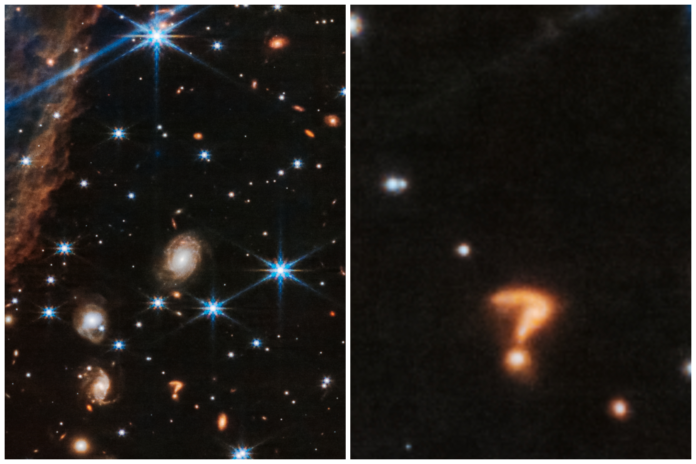Space is filled with weird and wonderful things, ranging from gigantic supermassive black holes to planets where it rains diamonds.
Sometimes, however, we spot things out in the abyss that look strangely familiar to us, such as household objects or animals.
One such discovery includes a strange punctuation mark lurking in the background of a new image from the James Webb Space Telescope.
The Cosmic Question Mark
The strange question mark, imaged by the NASA/ESA/CSA James Webb Space Telescope. NASA, ESA, CSA, J. DePasquale STScI
Hidden within a picture of the Herbig-Haro 46/47 is a bizarre object that looks exactly like a question mark.
The exact identity of this object remains a mystery, but we know from its redder hue that it’s incredibly far away from the Earth—light is shifted into the red end of the spectrum for objects moving away from us.
Horsehead Nebula
This image shows two different views of the Horsehead Nebula. On the right is a view of the nebula in visible light, taken using the European Southern Observatory’s Very Large Telescope in Chile (eso0202a). The new image on the left shows the nebula in the infrared, using observations from Hubble’s high-resolution Wide Field Camera 3. NASA, ESA, and the Hubble Heritage Team AURA/STScI; ESO
Another cosmic oddity that looks like something much closer to home is the Horsehead Nebula, which looks like—as you might imagine—a horse’s head.
The Horsehead Nebula is a dark nebula in the constellation Orion, situated around 1,375 light-years from Earth. It was discovered for the first time in 1888, and is a stellar nursery, with stars forming within the thick clouds of dust and gas that comprise the nebula.
Space Skull
This image, taken by Hubble on June 19, 2019, shows two huge galaxies colliding to form the shape of a skull. NASA, ESA, Julianne Dalcanton UWashington), Benjamin F. Williams UWashington, Meredith Durbin (UWashington
A bizarre skull-shaped collision between two galaxies was snapped by the Hubble Space Telescope in 2019, named the Arp-Madore 2026-424 system.
Each “eye” of the skull is a colliding galaxy, situated 704 million light-years from Earth. The galaxies will take between 1 and 2 billion years to fully collide and combine.
Mickey Mouse
Three craters on Mercury coincide to appear like the Mickey Mouse symbol. NASA/Johns Hopkins University Applied Physics Laboratory/Carnegie Institution of Washington
Though there is no life on Mercury, the solar system’s closest planet to our sun, there is a familiar-looking mouse.
In 2012, a crater named Magritte was snapped on the surface of Mercury, and a nearby set of craters caught the public eye due to its resemblance to Disney’s Mickey Mouse. These craters likely formed at very different points across the planet’s long and dynamic history, coming together serendipitously.
Mars Spoon
A spoon-shaped outcrop of rock on the surface of Mars. NASA/JPL-Caltech
In another case of a strange phenomenon closer to home, a strange spoon-shaped rock was photographed by Mars’ Curiosity Rover in 2015.
The utensil-shaped object also appears to be floating above the Martian surface due to the spoon-like shadow below it. However, this is likely because it is an outcrop from a neighboring rock, having been carved out by wind over several million years.
“There is no spoon. This weird Mars feature is likely a ventifact—a rock shaped by wind,” NASA wrote in an image description.
Cat’s Eye Nebula
The Cat’s Eye Nebula, formed by a star dying and ejecting its innards into beautiful layers surrounding it. NASA, ESA, HEIC, and The Hubble Heritage Team STScI/AURA
The Cat’s Eye Nebula, like the Horsehead Nebula, is named for its Earth-bound doppelganger.
This nebula is located in the northern constellation of Draco, around 3,300 light-years away from the Earth.
Its spectacular rippling rings are a result of a dead star that ejected its mass in pulses of stellar gas and dust, forming shells surrounding the dead core.
Death Star Moon
Mimas, a moon of Saturn, has a large crater named Herschel that makes the moon resemble the Death Star. NASA/JPL/Space Science Institute
While not a match for any real-life Earth object, Saturn’s moon Mimas bears a strong resemblance to the Death Star ship from Star Wars.
Mimas’ characteristic crater—named Herschel after English astronomer William Herschel, who discovered Saturn’s moon in the 1700s—is around 80 miles across, nearly one-third of the moon’s entire diameter.
All of these uncanny cosmic objects make us think of familiar things due to a phenomenon called pareidolia, which is a strange quirk of perception that makes us see familiar patterns in random arrangements or objects. Other more Earthly examples of this include seeing faces in the fronts of houses, or familiar figures burned into toast.
Do you have a tip on a science story that Newsweek should be covering? Do you have a question about space oddities? Let us know via science@newsweek.com.




